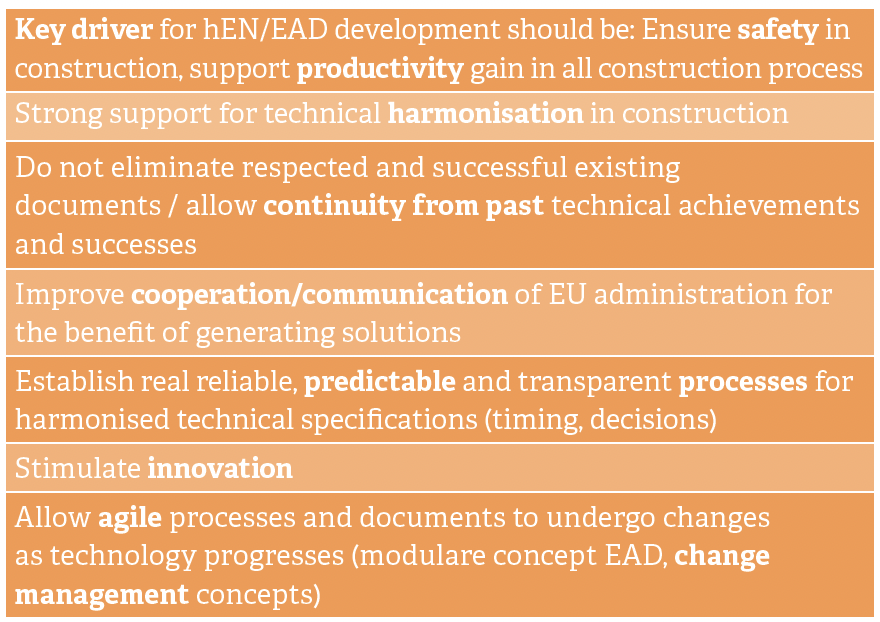
By Dr Ulrich Bourgund and Thomas Holland-Letz, Construction Fixings Europe Association
On 30th March 2022 the European Commission (EC) published the draft of a new Construction Product Regulation (CPR). The draft document covers all construction products technically specified via harmonised European Standards (hEN) and European Assessment Documents (EAD).
The intention of the EC is to further develop the construction market in Europe towards more digital and environmentally friendly concepts – while maintaining a level playing field, e.g ensure a high level of harmonisation across member states.
The political process for the CPR in the meantime has progressed substantially. The draft CPR released by the EC has been reviewed and commented on by the EP (European Parliament) and by a Working Group of the European Council, which provides a consolidated input from member states. The final phase for releasing the CPR is called the trilog, which is the process to develop a compromise text for each and every article in the CPR. As of today, the trilog is planned to be finished towards the end of 2023 in order to allow the CPR to be released before the upcoming EU elections in spring 2024.
One important achievement is that, according to all three positions, the route to CE Marking based on European Technical Assessments (ETA) for products or intended uses, which are not (fully) covered by a harmonised European Standard (hEN), will be maintained.
Taking a closer look at the ETA related part of construction products, it can be noticed that the issuing of product ETAs is fast and efficient as soon as the respective EAD is published in the OJEU. For new or updated EAD this is not the case because those documents – after their final adoption by EOTA – are not published until months or years later, despite clear deadlines for publication (just a few weeks) in the existing CPR. Manufacturers therefore have found themselves in a situation where ETAs have been issued, which triggers the mandatory CE Marking, but – from a pure legal point of view – CE Marking is not possible as the publication of the EAD in the OJEU is still missing. Despite such legal uncertainties, the availability of an ETA with high credibility for end users provides a value for the companies already in this phase. The major pain point for the industry is the unpredictability of the publishing date, which leads to legal uncertainty, major delays of market introduction of new products and the respective financial losses. 
The detailed needs from industry on the general legal framework CPR is given in Figure One.
The current status (as of August 2023) of the CPR document will impact the ETA driven product qualification in some key areas:
1. The validity of ETAs is now limited to 10 years. This will lead to possible additional costs for reissuing the ETA on one hand, but also force a quality check after years of application and technical progress.
2. The European Assessment Documents (EAD) will also be limited for 10 years. This may create confusion towards the end of the 10 year period with manufacturers because of limited predictability. In the marketplace we also may see more than one version of ETA related to the same product type and same intended use.
3. The issuing of the first ETA, based on a newly developed or updated EAD, will only be possible after the respective citation of the EAD in the OJEU. Based on current experience with deadlines of publication (up to years instead of weeks requested in the existing CPR) expected from the European Commission, this will substantially delay the market introduction of new products in the construction sector. The expected delay and the unpredictability of EAD publication will make the ETA route unattractive for the industry. As a result, some manufacturers may prefer to apply for national product qualification documents in selected member states –
because the predictability for publication is perceived to be much higher. This is clearly a momentum of deharmonisation, which is against the general targets of the EC.
4. Beyond this aspect the further delay of the publication will reduce the very sensitive topic of confidentiality on the EAD development. In future, manufacturers that applied for an ETA for a new product of intended use, which triggers the development of a new EAD, will be concerned to lose their advantage during the extended phase before their ETA is issued. Reduced trust in confidentiality will again make the ETA route less attractive.
5. Last but not least, the current procedure to issue a first ETA before a new EAD is cited in the OJEU provides a final ‘reality check’ of the EAD content based on the experience gained with this first ETA. This check will be missed in future if the sequence is changed due to the CPR draft.
In summary the current status of the CPR development will bring few improvements and clarity to the ETA route for product qualification in Europe. On the other hand, the lack of predictability on timing – this estimation is based on more than 10 years of experience of unkept deadlines for publication – and the further delay of first ETA issuing, based on a new EAD, will most probable make the ETA route less attractive for the industry. This potentially will trigger a revitalisation of national product qualification streams and ends up in deharmonisation.
It is hoped by the authors that the identified critical dimensions in the draft CPR will be resolved during the trilog process in the months to come.
www.construction-fixings.eu

Will joined Fastener + Fixing Magazine in 2007 and over the last 15 years has experienced every facet of the fastener sector - interviewing key figures within the industry and visiting leading companies and exhibitions around the globe.
Will manages the content strategy across all platforms and is the guardian for the high editorial standards that the Magazine is renowned.
Don't have an account? Sign Up
Signing up to Fastener + Fixing Magazine enables you to manage your account details.